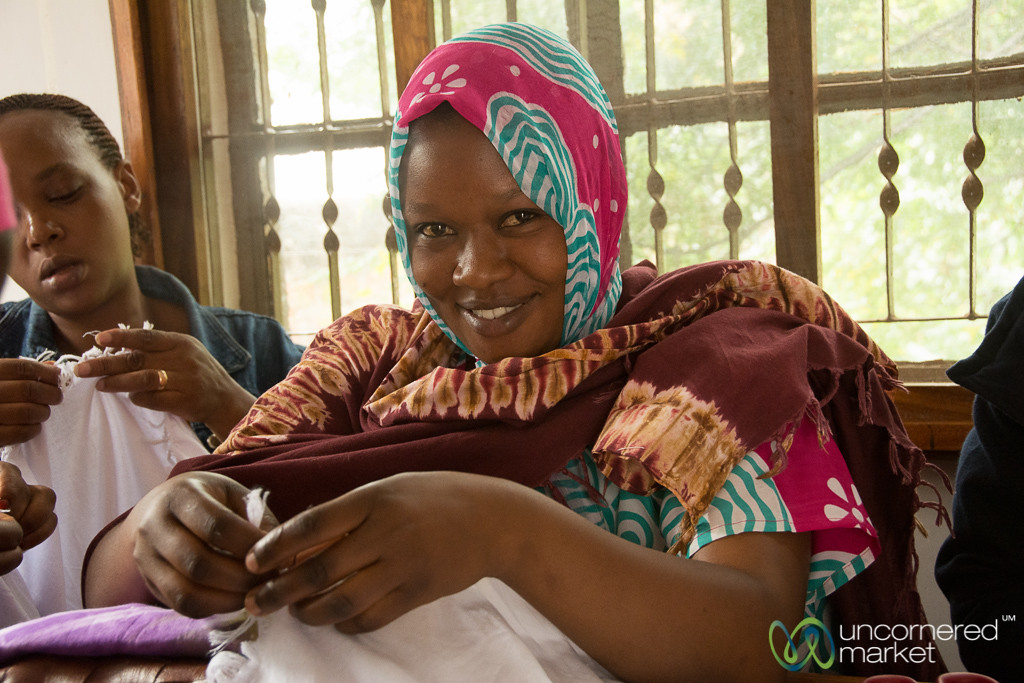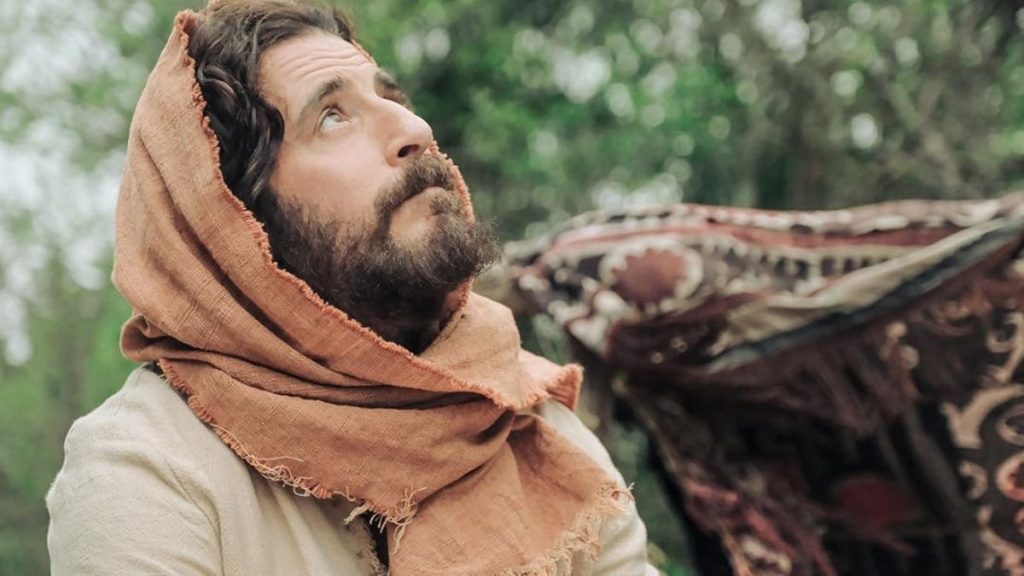Last Updated on January 6, 2023 by Audrey Scott The hike to the Lost City in northern Colombia takes you 46km (28 miles) round trip through the jungles, hills and river valleys of the Sierra Nevada Mountains. We’d had...
Last Updated on January 6, 2023 by Audrey Scott
The hike to the Lost City in northern Colombia takes you 46km (28 miles) round trip through the jungles, hills and river valleys of the Sierra Nevada Mountains. We’d had our sights set on the Lost City Trek for years, so expectations had built up. Fortunately, the challenge, landscape, and experience exceeded so many of them.
This Lost City Columbia Hiking Guide shares why that is and includes a day-by-day overview of the Lost City Trek, all you need to know to choose the right tour, how to pack and organize so that you can enjoy the Ciudad Perdida and this multi-day hike to the fullest.
We were out of breath, having just climbed 1,200 stone steps when Celso, our indigenous guide, called for us to join him around a group of stones arranged in a circle in a clearing. In the middle of the circle stood another square stone on top of which lay a pile of coca leaves placed as an offering. Celso explained with trademark calm in a slow, deliberate voice, “This is a place where we should let go of our impurities, our negative thoughts and emotions.”
We stood in silence, not only to “cleanse” ourselves so that we might better experience this sacred site, but also to enjoy its peace and quiet. To Celso, we were then prepared to further visit Teyuna, otherwise known as the Lost City (La Ciudad Perdida) in Colombia, the ultimate destination to which we’d been trekking in the rain forest for the previous two days.
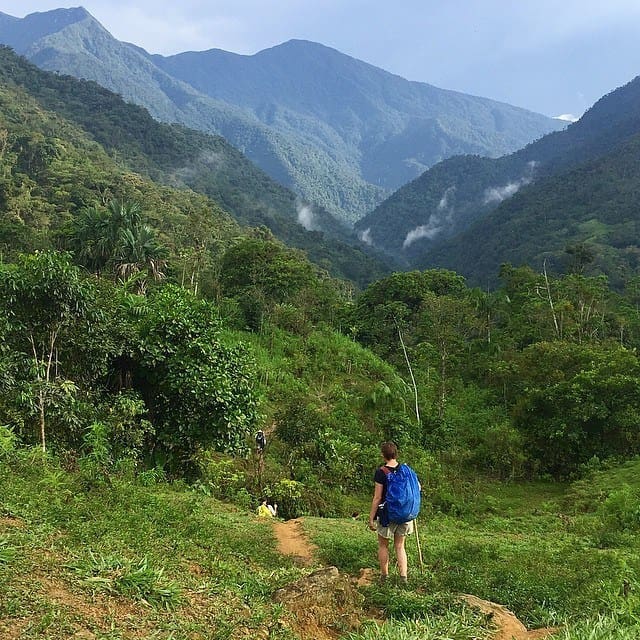 A taste of landscape along the Lost City Trek.
A taste of landscape along the Lost City Trek.Here’s why you might want to consider putting the Lost City or Ciudad Perdidia in Colombia on your travel or hiking wish list, in case it isn’t there already. In this Lost City Colombia Guide we include the day-by-day hiking experience plus all you need to know about to choose a Lost City tour and how plan, prepare for and pack to be able to enjoy the complete Lost City Colombia experience.
Update: This article was originally published in June 2015 and updated in May 2022 with information about the new G Adventures Lost City Trek itinerary.
The following experiences are from our G Adventures Lost City Trek. If you are considering this tour and want to know what to expect, here’s a taste of the itinerary and route, interaction with local indigenous guides, campsites and Wiwa community project. Disclosure: This tour was sponsored and provided to us in conjunction with our partnership with G Adventures as Wanderers.
About this Lost City Colombia Trek Guide
When I researched the Lost City Trek as part of our travels in Colombia, I found a fair bit of conventional history about the site, often paired with a photo or two of the final destination, including what I refer to as the “golf course” shot.
What I didn’t find much of was information on what the actual journey to the Lost City was like, including the hiking experience, difficulty, landscapes, sleeping and eating conditions, weather, and more. That's the goal of this Lost City Trek day-by-day section.
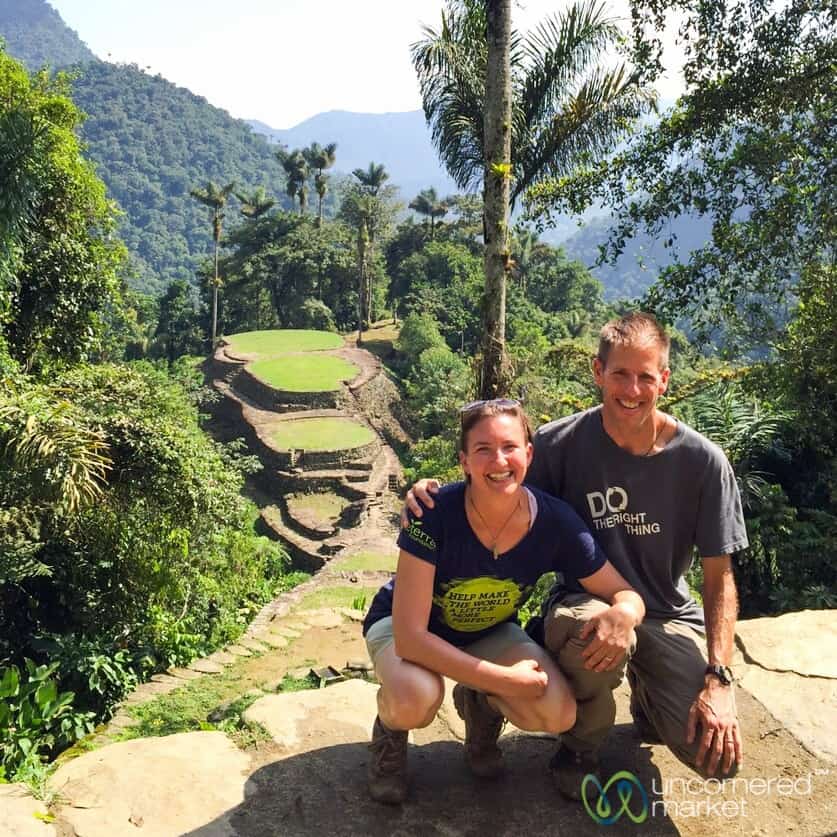 Us in front of the “golf course” shot.
Us in front of the “golf course” shot.The landscape along the trail is more beautiful and varied than we had expected and the Lost City site itself is far more extensive than most photos indicate. We especially appreciated having an indigenous guide to put everything into cultural and historical context.
Celso, a member of the local Wiwa indigenous community, shared his culture with us and linked it to the other indigenous communities, their relationship to nature and their shared connection to the ancient Tayrona civilization.
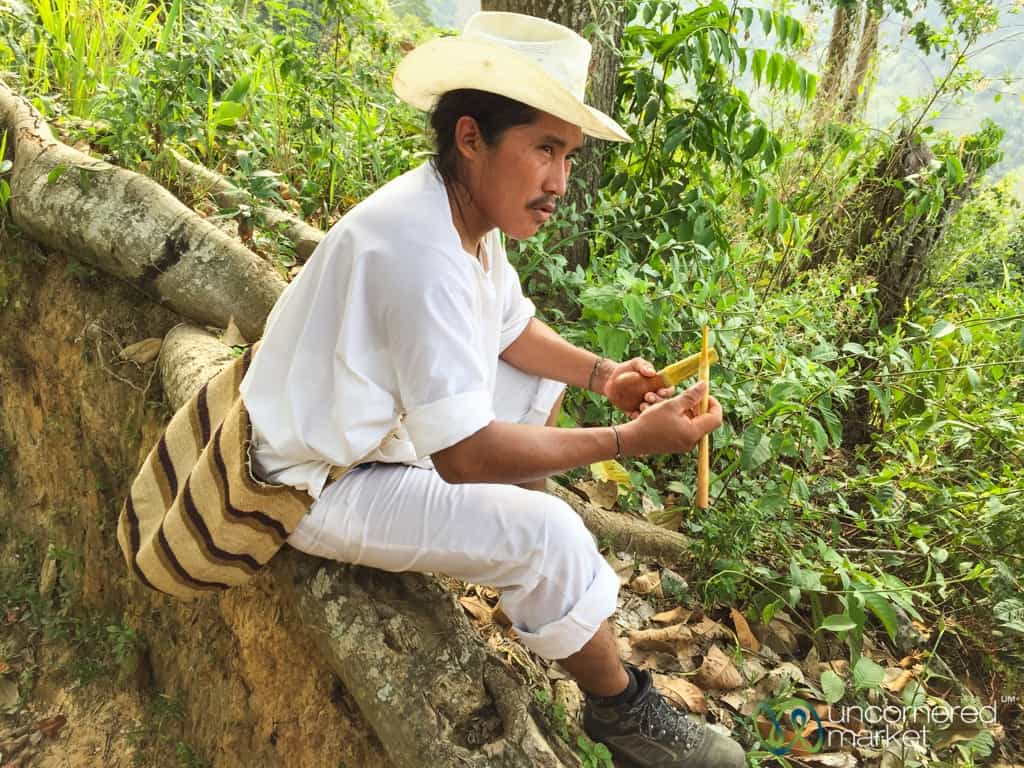 Our Wiwa guide, Celso, with his poporo, a gourd used for carrying crushed seashells (lime).
Our Wiwa guide, Celso, with his poporo, a gourd used for carrying crushed seashells (lime).Our days usually began early, around 5:00 A.M., so we could get on the trail while it was still cool and so that we could complete our day’s journey before the rains of the mid-late afternoon. We appreciated getting up early, and we enjoyed all the benefits of the early morning – light, coolness and silence among them.
Lost City Trek Map
The map below shows the basic Lost City trail with different options for campsites and sections. We did a four-day hike, but if you opt for a five-day Lost City trek then your second and third days will be shorter as you'll have two days to complete that same route. The current G Adventures Lost City Trek is five days.
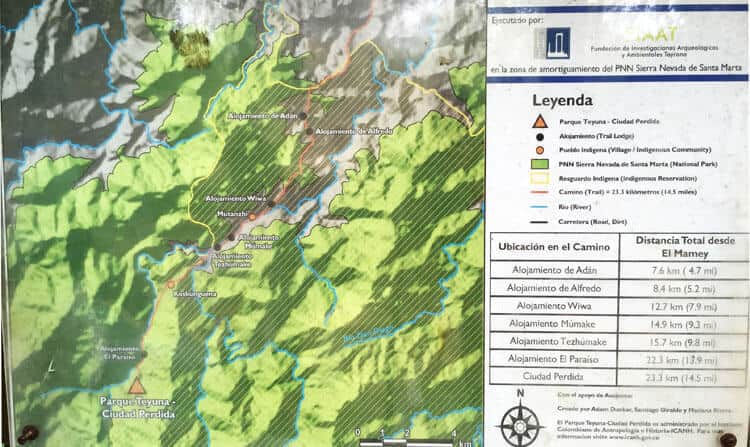 Lost City trailhead sign with route, campsites and distances.
Lost City trailhead sign with route, campsites and distances.Hiking to the Lost City in Colombia: Day by Day Itinerary
Day 1 of the Lost City Trek
All Lost City treks, no matter which tour company you choose, seem to set off from Santa Marta in northern Colombia. From there, a jeep or van transfer takes 45 minutes along the highway.
You’ll likely stop at a convenience store for last minute snacks and water. From there, you’ll head up a dirt track into the mountains.
After you arrive in Machete, you’ll have lunch, say goodbye to the driver and meet your local indigenous hiking guide. Then, the hike begins. (Note: this is when you should ask the people coming off the trek if they have a walking stick they can give you. It is really helpful for balance and ease on the trail.)
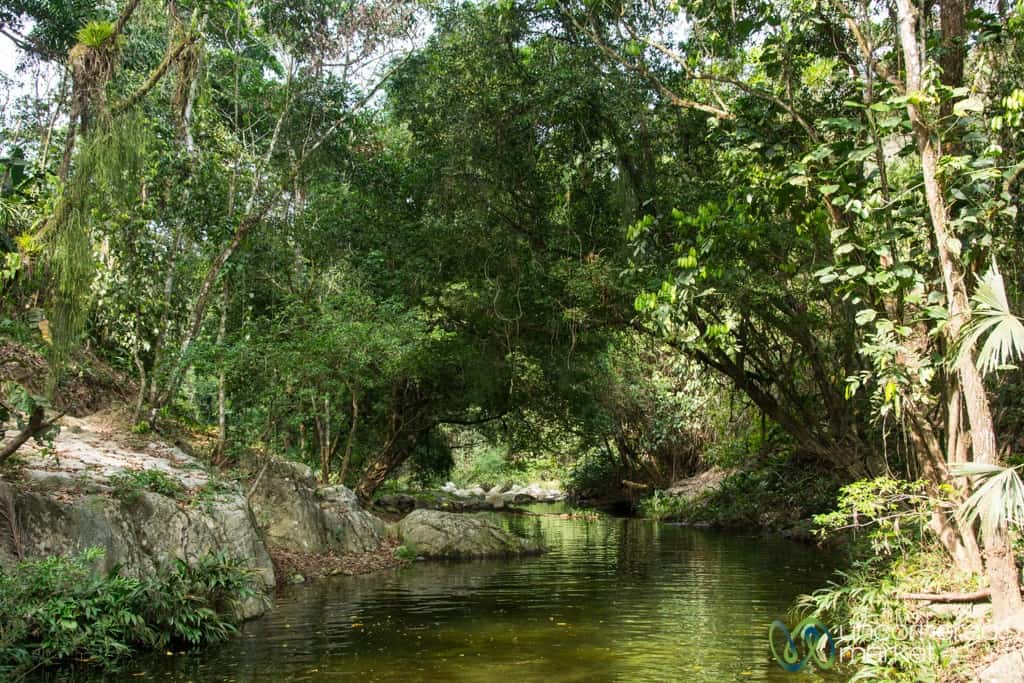 The first of several swimming holes along the trail.
The first of several swimming holes along the trail.The beginning of the walk eases you into things, with a swimming hole a close 25 minutes from the trailhead. After cooling off in the water, you’ll have a steep uphill for around 45 minutes, then a bit of a break, then a long descent into the valley where the first campsite is located.
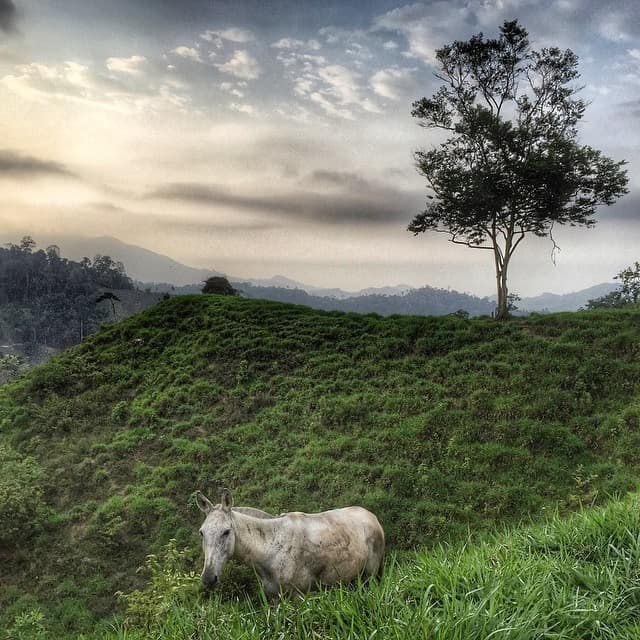 Everything on the trail comes up on the backs of mules or horses.
Everything on the trail comes up on the backs of mules or horses.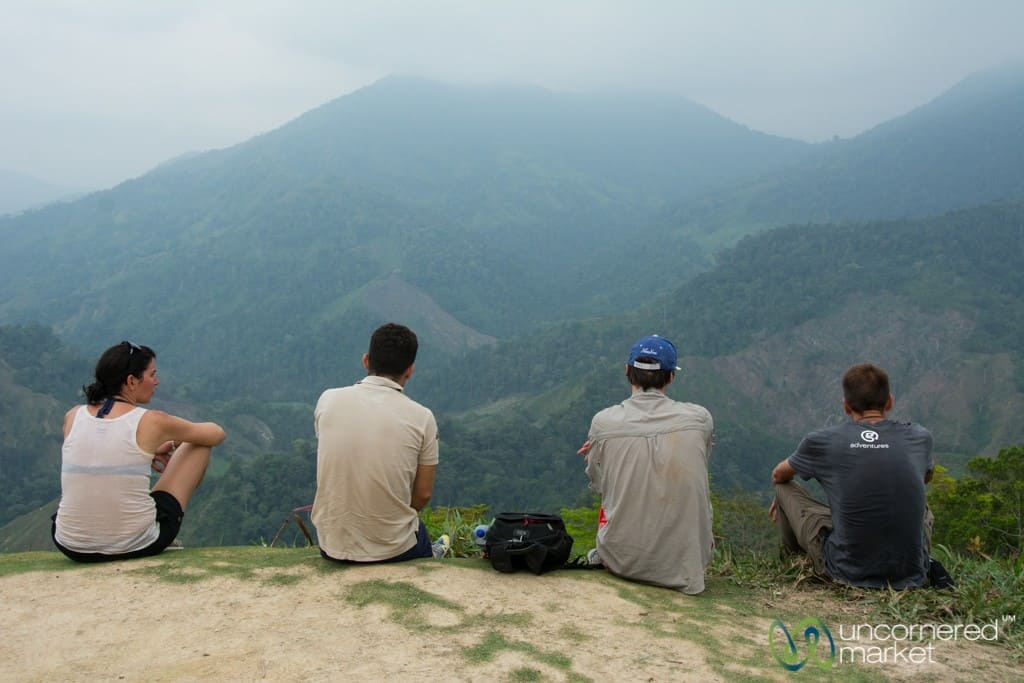 Enjoying the view during a fruit and water break, Day 1.
Enjoying the view during a fruit and water break, Day 1.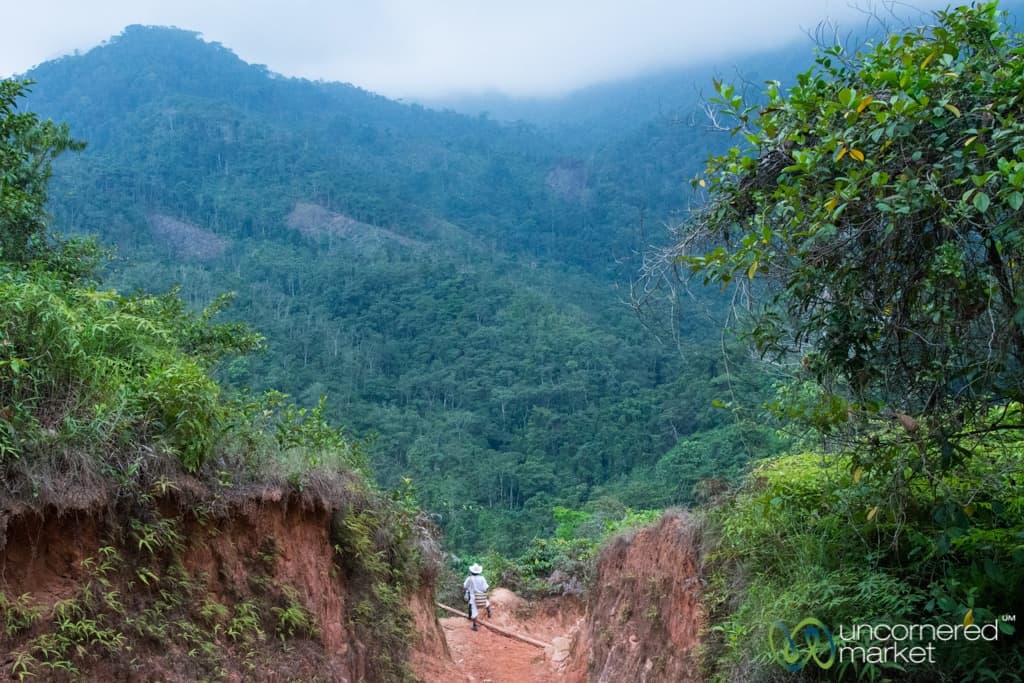 Steep terrain into the valley of the first campsite.
Steep terrain into the valley of the first campsite.Day 2 of the Lost City Trek
If you are doing a 4-day Lost City Trek, then this is a long hiking day. If you are doing a 5-day route like the G Adventures Lost City Trek then this will be a similar distance as the previous day, 7-8 km, to Wiwa Camp (Campsite #2).
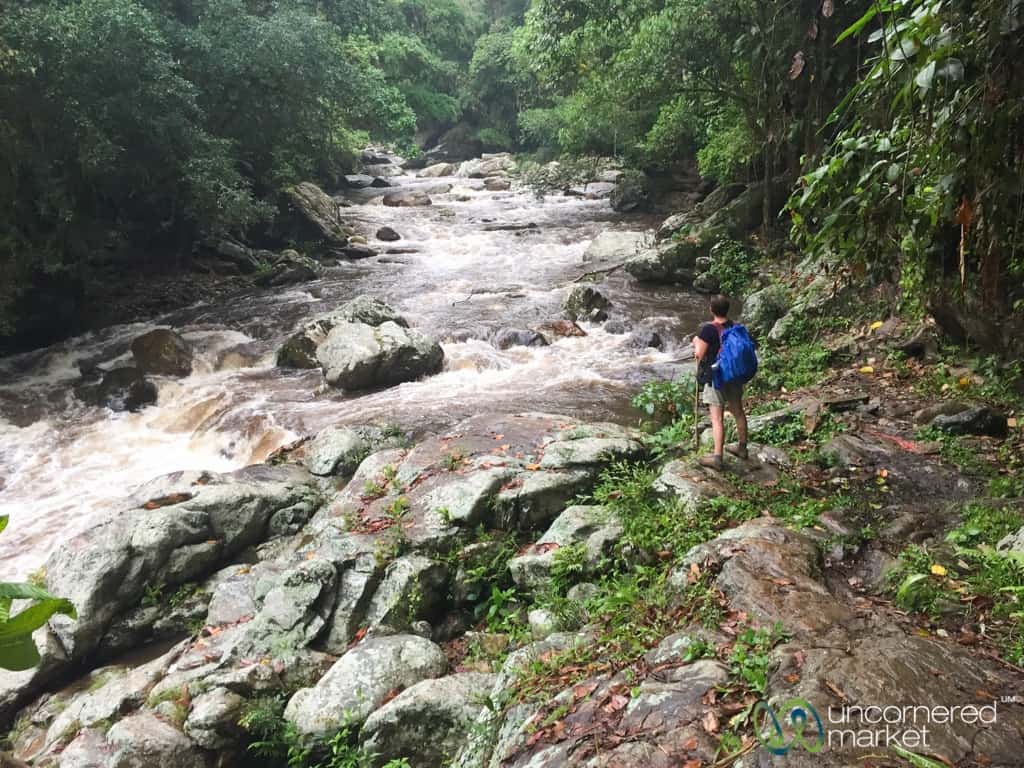 The trail crosses Rio Buritaca several times during the journey.
The trail crosses Rio Buritaca several times during the journey.The first segment of the day takes you uphill and across some beautiful terrain, including some local farms. After a jump in a swimming hole and lunch at Campsite #2 (Wiwa Camp), we continued all the way to Campsite #3 (El Paraiso or Paso Lorenzo Camp), located only 1 km downhill from the site of the Lost City.
If you are doing the 5-day Lost City Trek, then you would stop at Campsite #2 for the night.
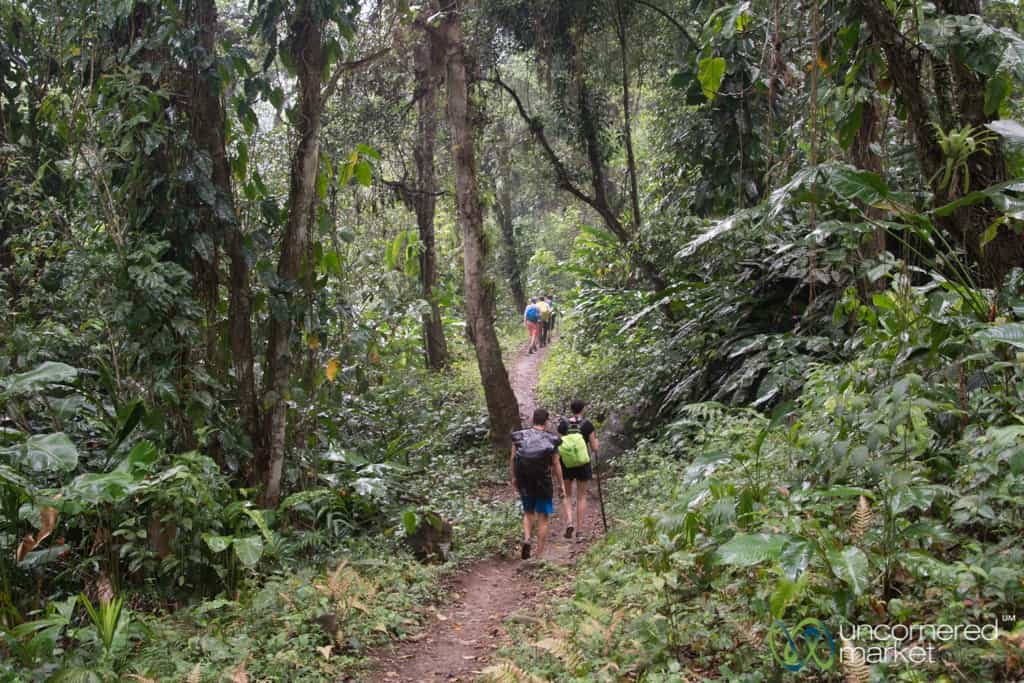 A little rain never hurt anyone…
A little rain never hurt anyone…This day takes you through a great deal of varied landscape — deeper into the tropical jungle, across rivers and by a couple of Kogi village communities along the way.
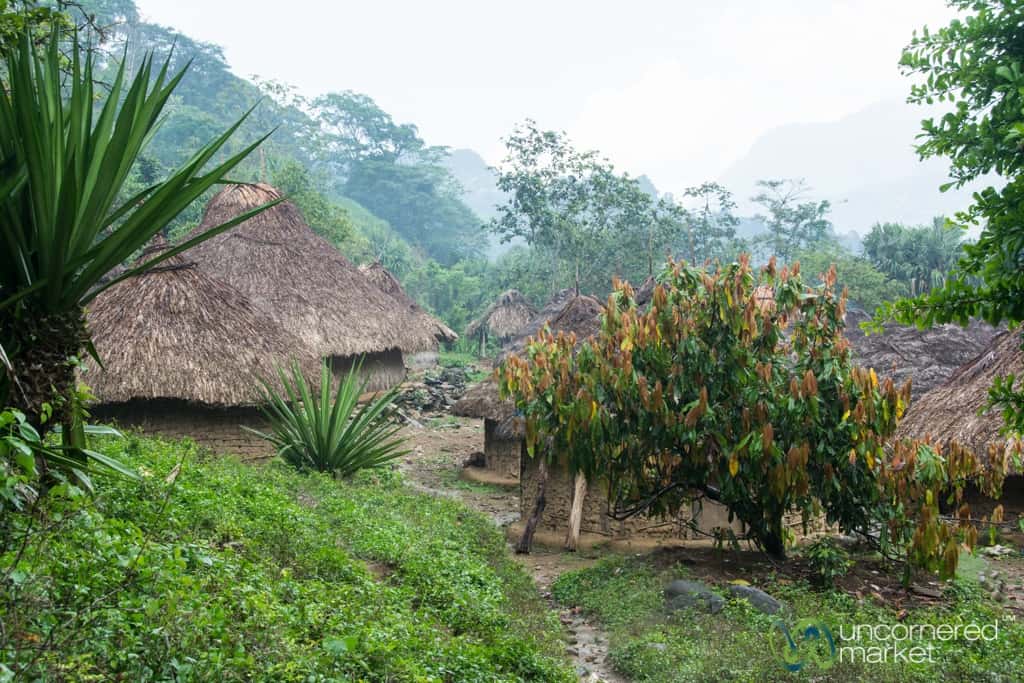 Passing by a small Kogi village.
Passing by a small Kogi village.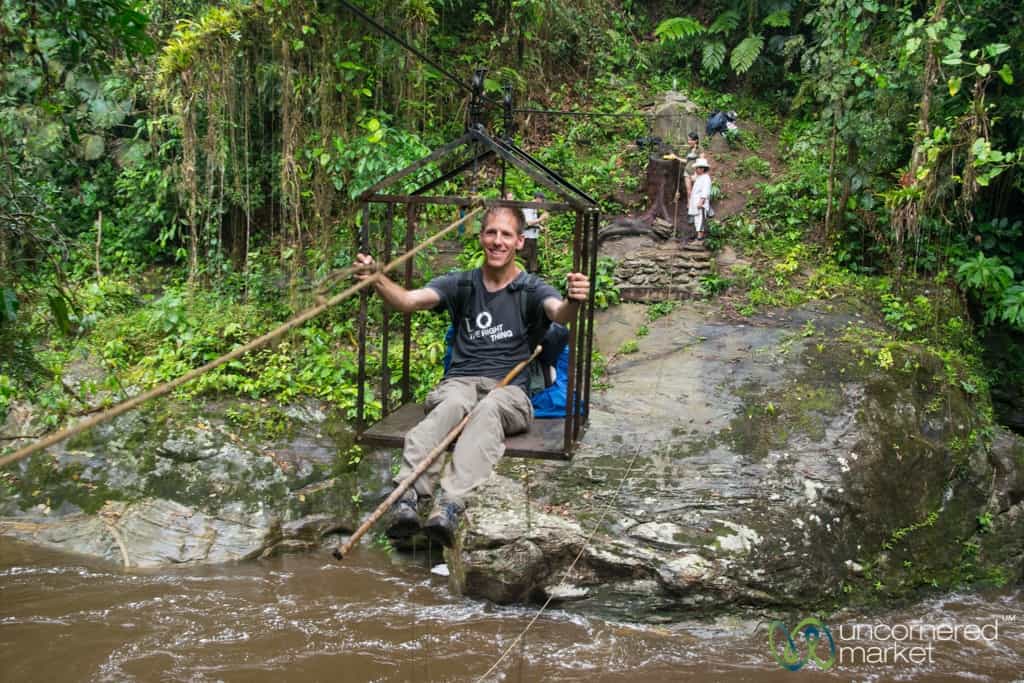 When the river is too high, you cross in a mid-air cage-like contraption. Don't worry, it's more secure than it looks.
When the river is too high, you cross in a mid-air cage-like contraption. Don't worry, it's more secure than it looks.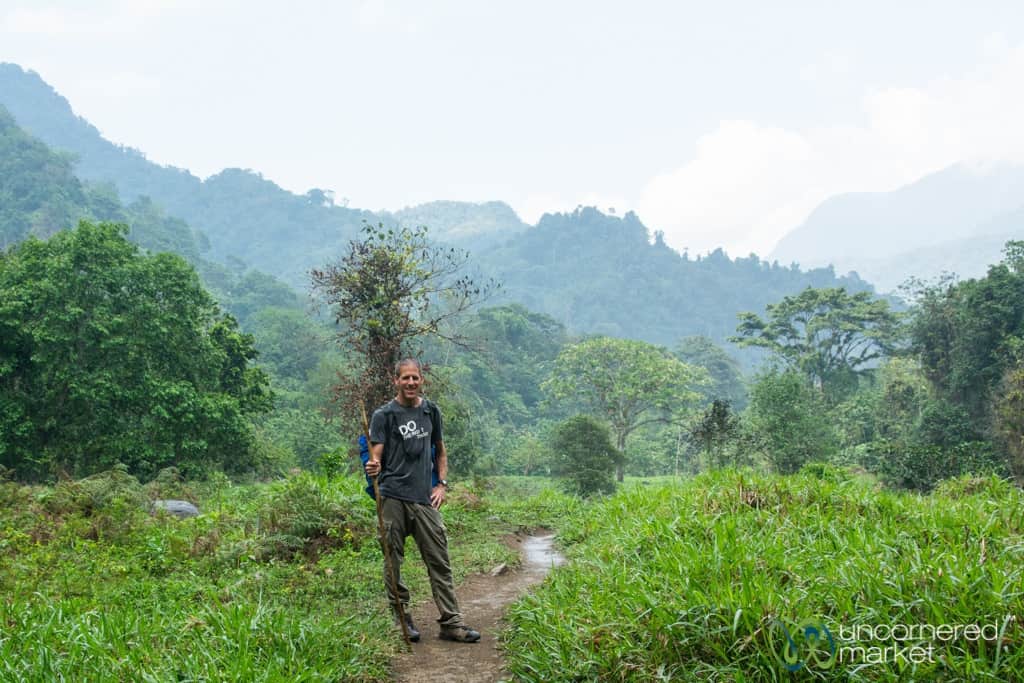 After the rains, enjoying the open landscape.
After the rains, enjoying the open landscape.Day 3 of the Lost City Trek: Visiting La Cuidad Perdida
You rise very early on this day (around 4:30A.M.) so that you can set off at dawn and enjoy the Lost City in the softest light and coolest air possible. After a short walk from the campsite, you reach the starting point of the 1,200 stone stairs you’ll need to walk and scramble to reach the terraces of the city above.
It’s not an easy climb, and can be a bit treacherous if wet or damp, but if you take care and get into a meditative rhythm, you’ll find it goes very quickly.
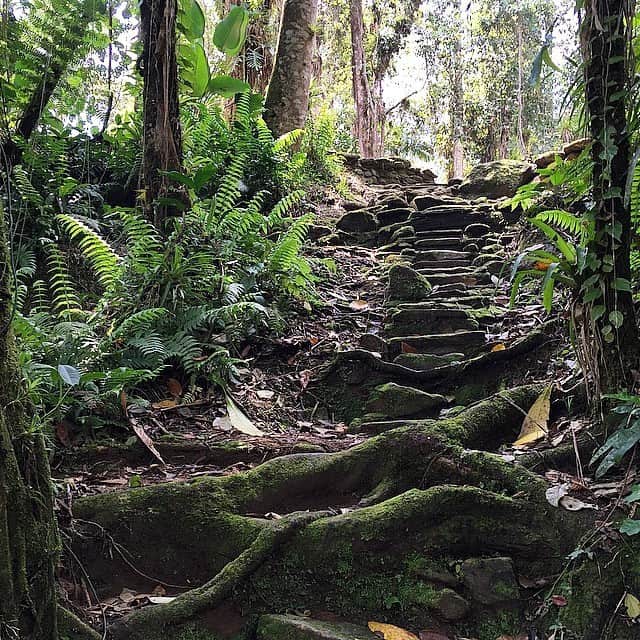 Slow and steady up 1,200 carved stairs.
Slow and steady up 1,200 carved stairs.After the steps, you’ll have reached the lower chambers of Teyuna, also known as The Lost City or Ciudad Perdida. It is believed that this was a capital city built by the Tayrona civilization in 800 A.D., approximately 600 years before the Incas built Machu Picchu in Peru.
When Spanish colonialists came close to finding or approaching the in the 16th century, the Tayrona people opted to abandon the city instead of allowing it to fall into Spanish hands.
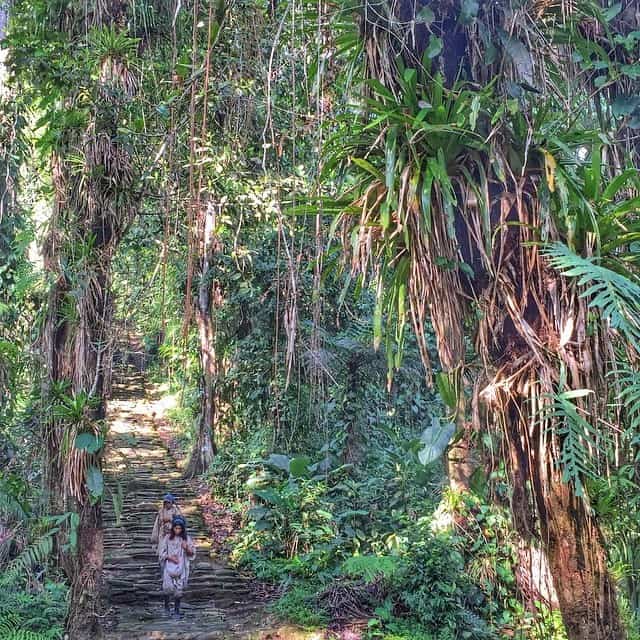 Two Kogi men return from the upper chambers of Teyuna.
Two Kogi men return from the upper chambers of Teyuna.Of course, the Lost City Colombia was never truly “lost.” Teyuna was overtaken by jungle for the next several hundred years, as only the shaman (holy men) of the four indigenous groups who live in the area were aware of its existence and would visit it regularly for ceremonies.
It wasn’t until the early 1970s that the site was “discovered” by the outside world. Tomb thieves cleared out much of the gold, valuable artifacts and other remains. Due to this misfortune and the fact that no written record of the Tayrona exists, much about the city and civilization remains the subject of speculation.
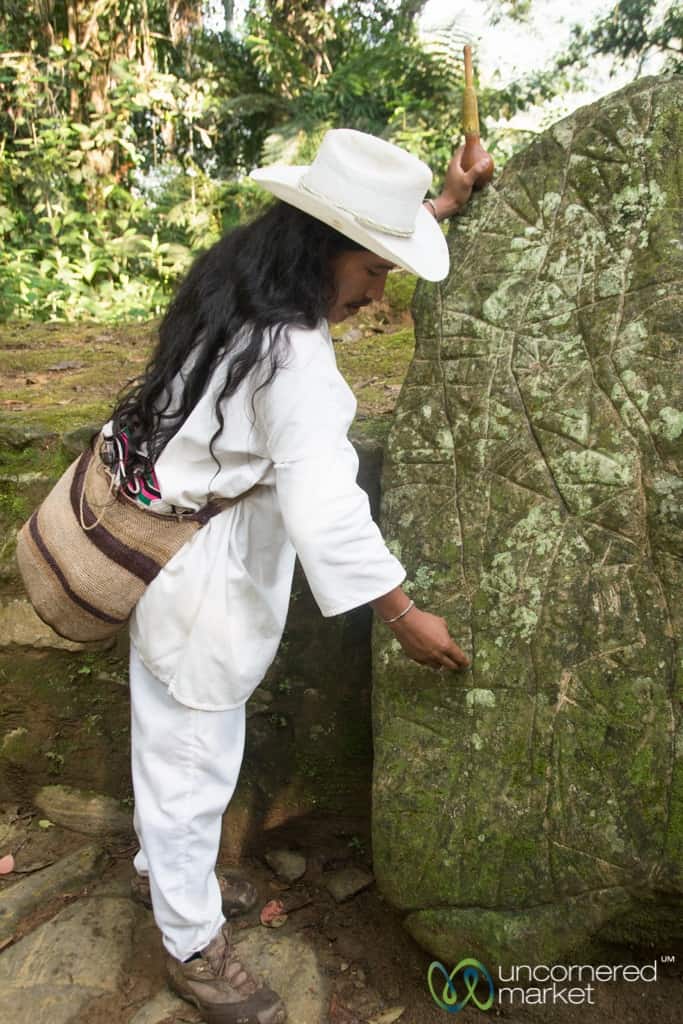 Celso explains the competing theories of the Lost City version of the Rosetta Stone.
Celso explains the competing theories of the Lost City version of the Rosetta Stone.The Wiwa, Kogi, Arhuaco, and Kankuamo indigenous groups that remain in the area are believed to be the descendants of the Tayrona and have carried on their stories and traditions.
We noticed when we arrived at the Lost City, Celso let down his hair, the surprising length of which is said to represent the wisdom that flows from the sacred mountains through the rivers to the coast. He was dressed in white, as was his custom, to represent the purity and integrity of the snow-covered peaks of the Sierra Nevada Mountains, out of sight in the distance.
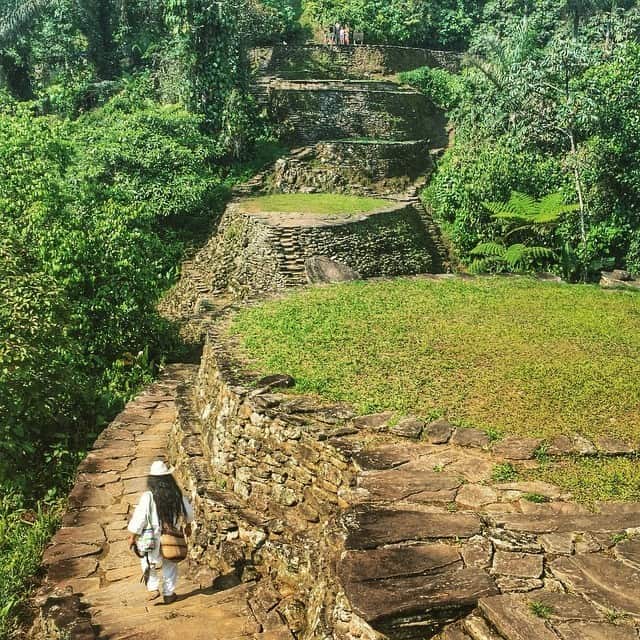 Celso leads us to the upper terraces of Teyuna, the Lost City.
Celso leads us to the upper terraces of Teyuna, the Lost City.Throughout our journey, he shared stories that had been passed on to him, through generations, from shaman to shaman, from elders to children, about the Lost City / Ciudad Perdida. The stories told of its creation, the symbolism of the different terraces, and the Tayrona relationship with nature.
The indigenous people that inhabit the area around the Lost City in Colombia believe they are the symbolic “elder brothers,” there to protect both the sacred Sierra Nevada Mountains and their “younger brothers” – meaning the rest of us.
The sense of responsibility to the equilibrium and the good and health of others was evident.
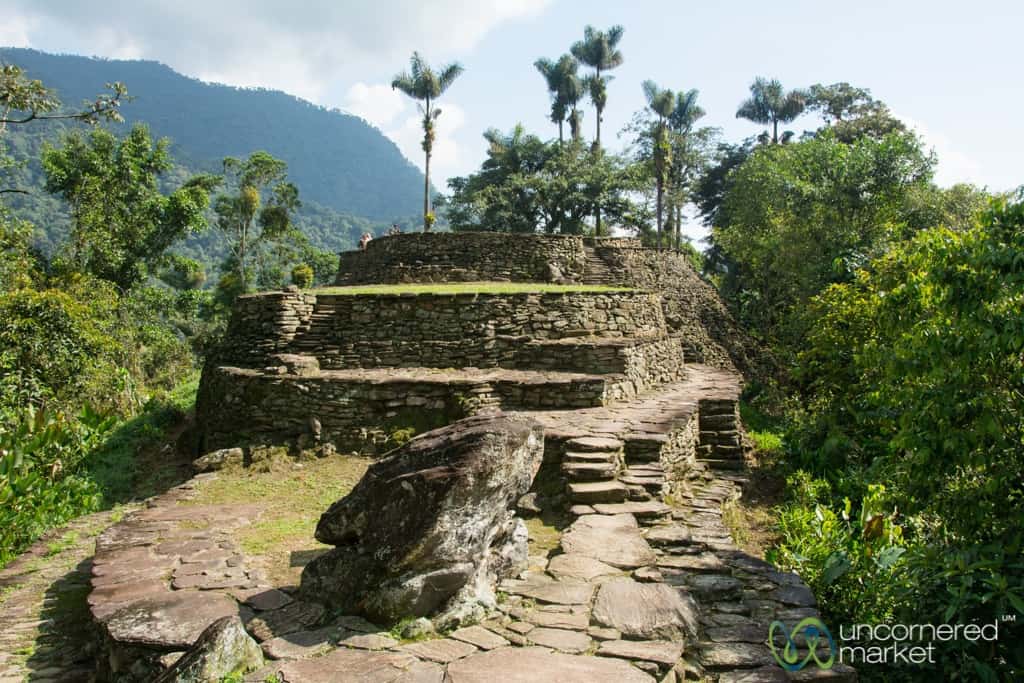 Approaching the upper chambers of the Lost City.
Approaching the upper chambers of the Lost City.After your visit to Teyuna, the Lost City, you return to El Paraiso or Paso Lorenzto Camp (Campsite #3) for a quick lunch and begin your return all the way to Wiwa Camp (Campsite #2).
For us, we were met with an afternoon downpour that made it feel as though we were skiing through mud crevasses in the rain forest. We were glad for the experience. It was actually more delightful than it sounds as the rain was warm and everything around was so green and lush drinking in the much appreciated water.
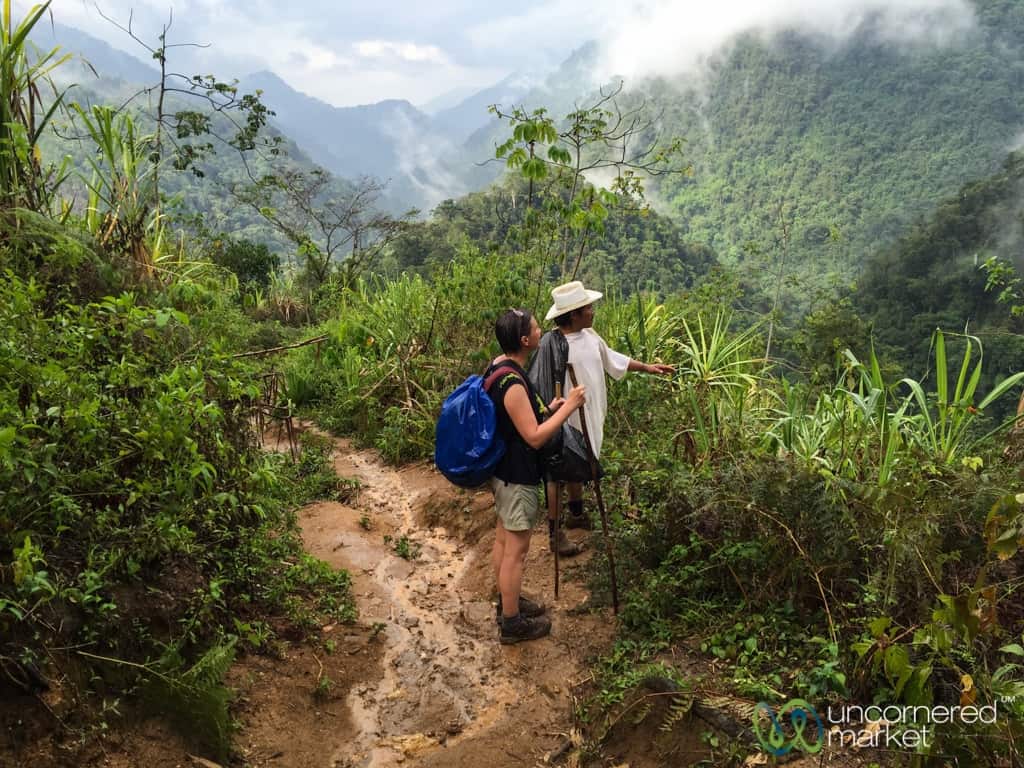 After the rains, watching the clouds rise up through the hills.
After the rains, watching the clouds rise up through the hills.Day 4 of the Lost City Trek
Start/Finish: Wiwa Camp (Campsite #2) to Machete and Santa Marta
Distance: 12.7km
This is another early rise since much of the trail is uncovered and therefore becomes quite hot as the day goes on. Try to make it as far as you’re able before the sun becomes too strong.
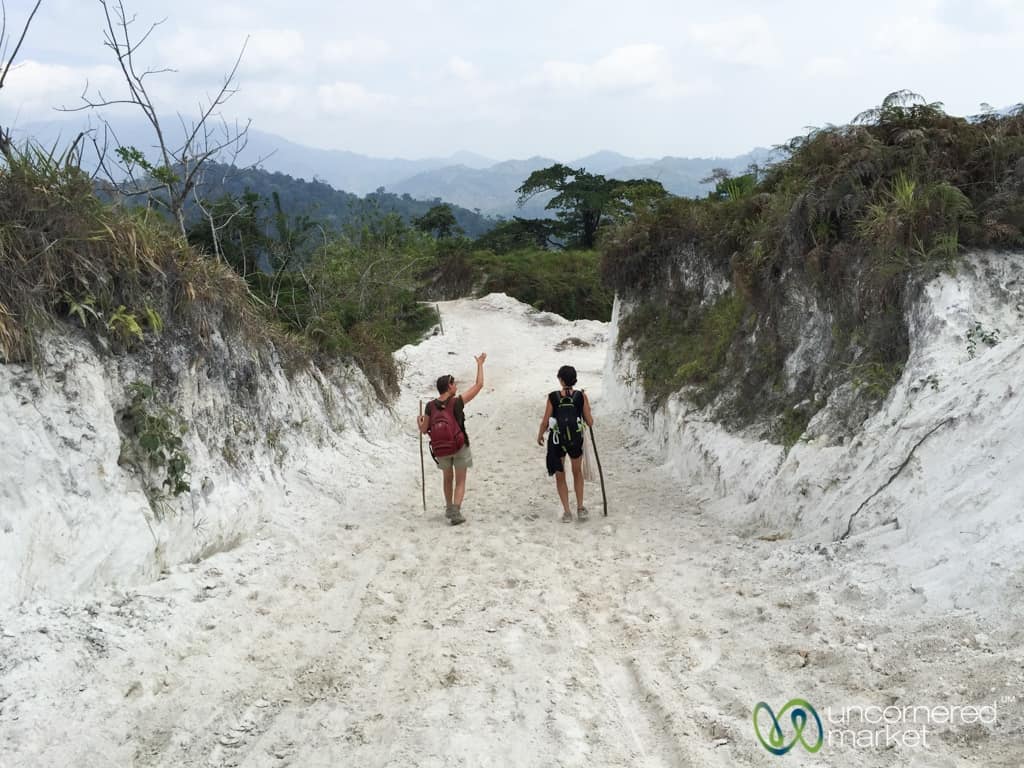 Through a limestone path en route to Machete.
Through a limestone path en route to Machete.As you’ll remember from your first day, much of the trail is up or down, without much in between. After a stop for fruit at the first campsite and a jump in the swimming hole, you find yourself back where you began, with a celebratory lunch in Machete.
Then you'll transfer by vehicle to Santa Marta for a nice, hot shower and to reunite with the rest of your stuff.
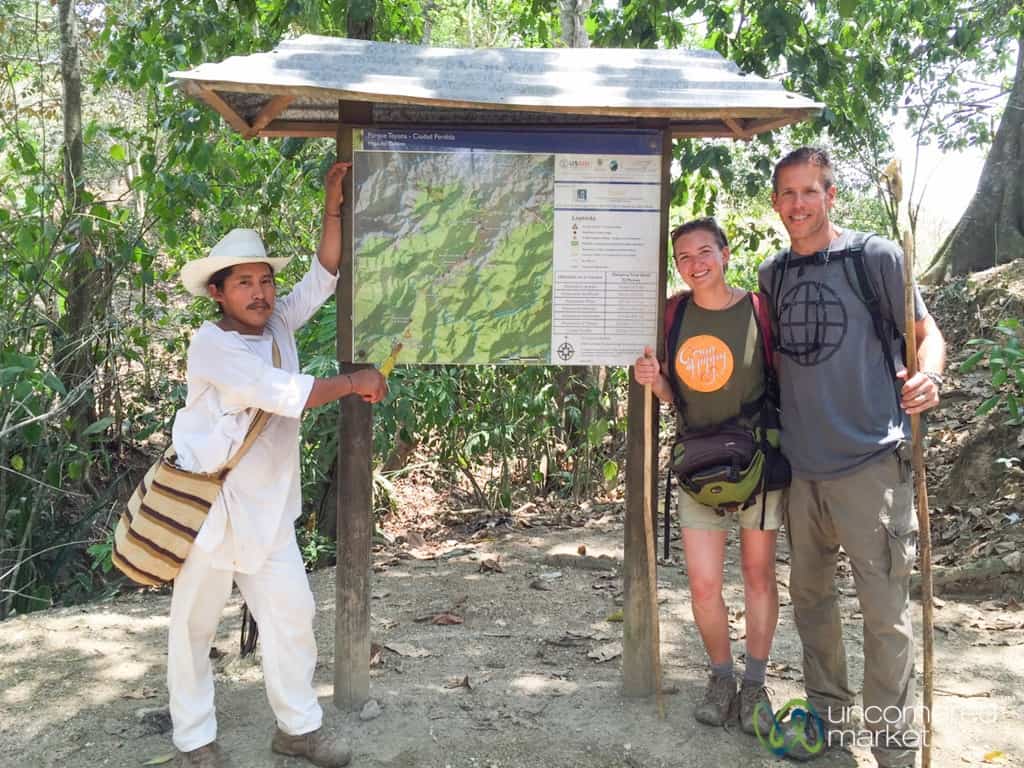 Back where we started, at the trail head sign in Machete.
Back where we started, at the trail head sign in Machete.Lost City Trek Difficulty and Hiking Conditions
We’d give this trek a medium-high difficulty ranking for all the reasons we’re about to elaborate. This means that you should not require special training to hike the Lost City Colombia trail, but you should be relatively active and in good physical shape.
You should either be accustomed to or be prepared for day-long treks with steep, slow uphill climbs and long walks in intense heat and humidity.
Lost City Trek is Not a Technical Trail
The Lost City Trek is not at all technical, meaning that you will not need any special equipment (e.g., climbing ropes or other fittings). The trail is well-maintained and for the most part, it’s an easy path to follow. But, it’s necessary to have a guide to navigate the rivers and some turns.
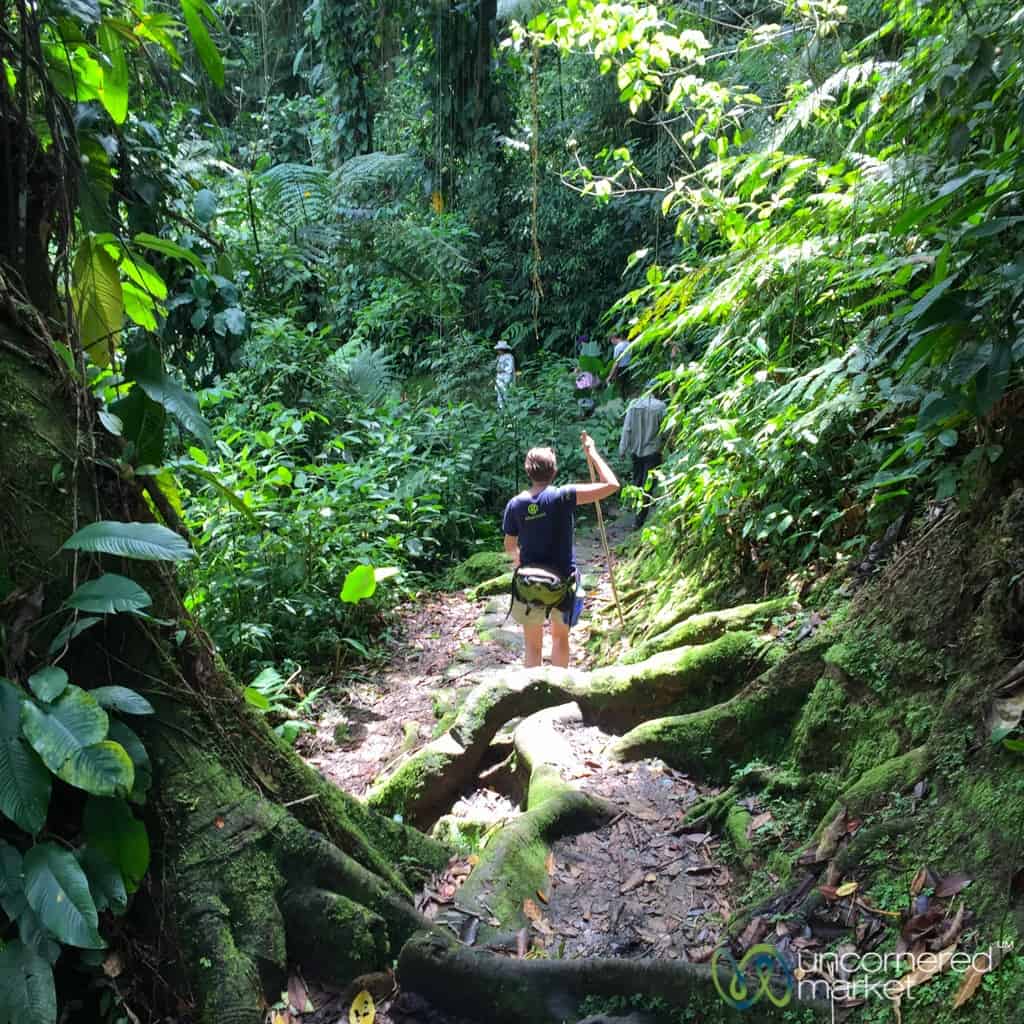 Through the tropical forest on the way to the Lost City stairs.
Through the tropical forest on the way to the Lost City stairs.You’ll have to cross a few streams or rivers — with river shoes on or with your shoes and socks in your hand — but that is part of the fun.
Altitude, Steep Hills and Valleys
Altitude is not really an issue, as the trek’s highest point is around 1,500 meters/4,920 feet. However, the Lost City trail seems to either be straight up or straight down without much flat so there's a lot of steep ascents and descents on the trail.
Our advice is to take it slow and steady on the uphill. Keep in mind that it’s not a race. It’s better to hike deliberately and slowly and take fewer breaks than to go quickly and wear yourself out with frequent and longer stops to recover.
Heat and Humidity
One of the challenges of the Lost City Colombia Trek is the combination of heat and humidity. I’m not sure we’ve ever poured sweat with such intensity and consistency. It actually felt great, like a cleansing process.
Just be sure that you drink plenty of water to replenish. Note that respite from the heat comes a couple of times a day in the form of rivers and swimming holes to jump into.
Bugs Along the Trail
Another challenge and irritation of this trek: bugs and their bites. There are lots of them, especially mosquitoes at the Lost City itself. We suggest applying plenty of bug repellent (bring on the DEET if you need to).
If you are especially susceptible to mosquito bites consider hiking in long trousers as Dan did. Finally, pick up a pack of generic B-complex tablets (“Compejo-B generico” runs 25 pills for $1.00) in a pharmacy in Santa Marta before the hike, as certain B vitamins are said to repel mosquitoes.
Another thing to watch out for are fleas and/or bedbugs in the hammocks and/or blankets at the campsites – this is where we collected most of our bug bites (especially campsite #2). We recommend carrying a sleep sack, so that you have another layer of protection while you are sleeping.
Finally, check your body closely for ticks when you emerge from the Lost City Trek. We each had a few on us; they are very tiny and difficult to see, so look closely. (Note: For advice on how to properly remove a tick, check out this article.)
Rain and Mud Along the Lost City Trail
We had been warned plenty about rain and mud, but didn’t find wet weather too much of a hindrance. Yes, it rained from time to time (usually mid-afternoon), but it was often so hot anyway that the cool rain was welcome.
Be certain any valuable electronic gear is well-protected and any dry sleeping clothes are at least wrapped in plastic (e.g., ziploc, garbage bags or a dry sack) inside your backpack. Then, have an outer backpack cover to protect your backpack from the elements.
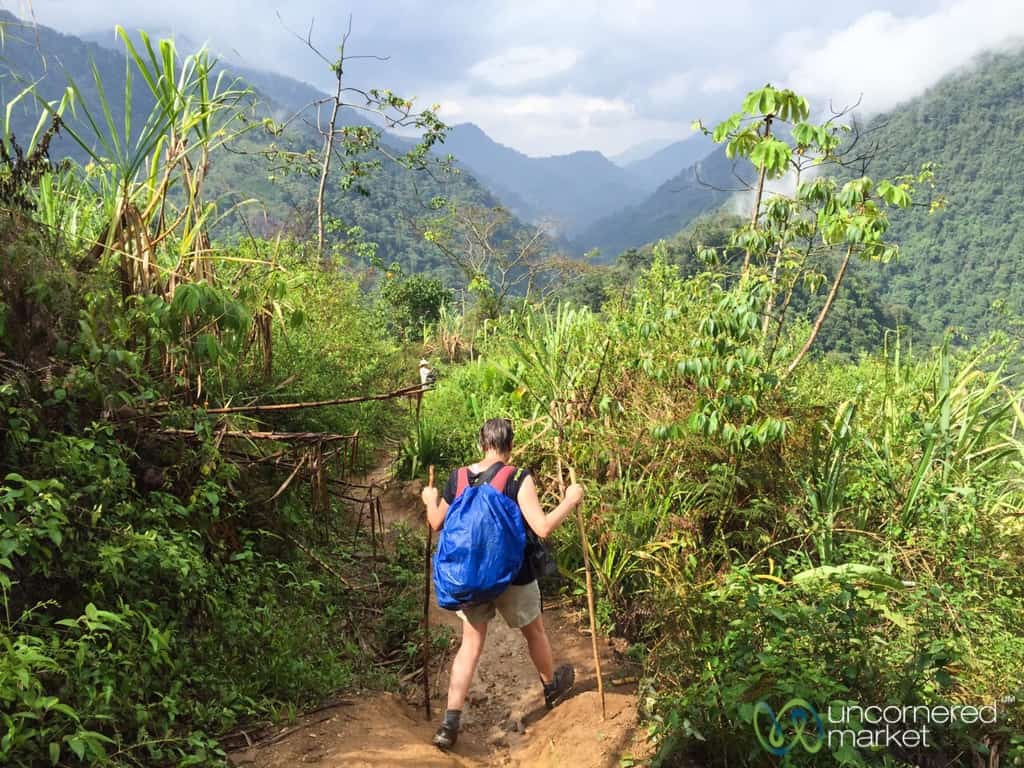 A little rain and mud just adds to the excitement.
A little rain and mud just adds to the excitement.If you fall in the mud, just go with the flow and don’t think about it too much. You can always wash yourself and your clothes later.
Best Time to Hike the Lost City Trail
While you will experience heat and humidity almost all year round in the Sierra Nevada Mountains of northern Colombia as it is a rain forest, there is still a rainy and dry season. December through March is considered the dry season and so it often is considered the bet time to hike the Lost City Trek.
In general, May through September is considered the rainy season for the region. This means expect more downpours and higher river crossings. That doesn't mean that you should avoid those months altogether as the rain can be a welcome relief from the heat and provide an interesting experience. For example, we did our G Adventures Lost City Trek in early June and thought the few rainfalls were kind of pleasant and added to the experience.
Note: The Lost City Trail is usually closed in September for trail maintenance and to do upkeep on the campsites and other services.
Lost City Trek Food
You will certainly not go hungry on the Lost City Trek. Each group is assigned a cook and not only will you be served three large meals a day (e.g., fish and rice, pasta, chicken and potatoes), but you will also enjoy well-placed fruit stops along the trail. These are very welcome for the additional boost of energy and hydration just when you need it.
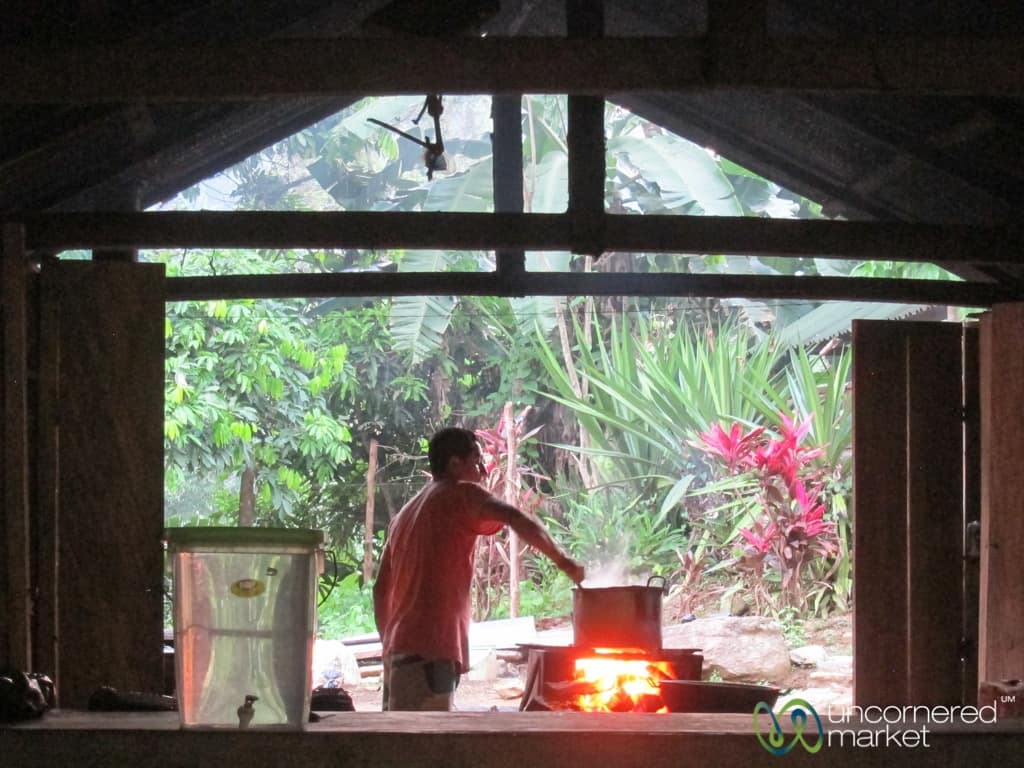 Enrique, our cook, made us a feast every dinner.
Enrique, our cook, made us a feast every dinner.If you are vegetarian or have food restrictions (e.g., gluten or lactose free), alert your trekking company and your guide in advance so they can respond accordingly.
Lost City Trek Campsites and Sleeping
There are a handful of different campsites along the way that the tour companies use. We can only speak firsthand to the ones that we stayed in — Adán Camp, Wiwa Camp, and El Paraiso — but we understand that the other campsites are quite similar in design, comfort and services.
Not always, but often, you’ll have an option to sleep in a hammock or on a mattress/bed (both with mosquito nets). We always chose the hammocks, but some may prefer mattresses.
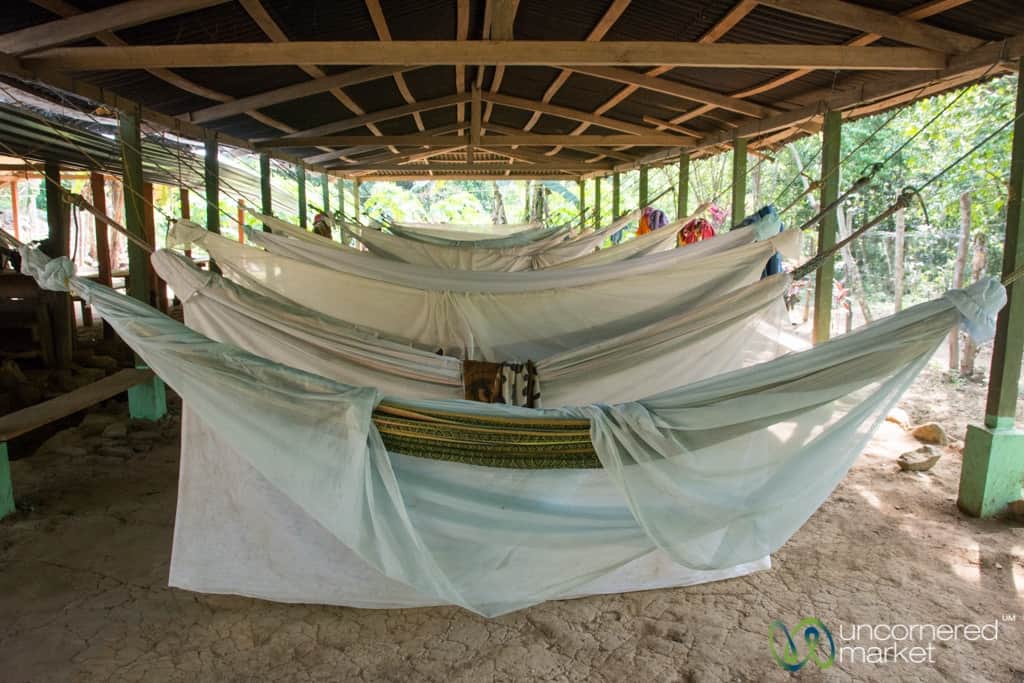 Sleeping along the Lost City Trek. Hammocks covered with mosquito nets.
Sleeping along the Lost City Trek. Hammocks covered with mosquito nets.There are cold water showers and flush toilets at all the campsites. Clotheslines will be strung around so you’ll be able to hang up your wet clothes from the day. However, the rain forest is damp so do not expect anything to fully dry overnight, if at all.
Evenings also get cool, so keep a long-sleeved shirt or fleece jacket handy at night.
Organizing a Lost City Tour: Your Options
Choosing a trekking operator
You cannot do the Lost City Trek independently (at this time), meaning you must go with one of the four or five authorized tour operators. We took our Lost City Trek with G Adventures and can highly recommend the experience.
G Adventures work with a local organization that provides indigenous guides so that their travelers are able to learn about the indigenous cultures and communities still living in the Sierra Nevada mountain area.
Regardless of which operator you choose to take you on the Lost City Trek, we suggest you select one that works with indigenous guides. The cultural and living history background is essential to a full Lost City Colombia experience.
How many days do you need for the Lost City Trek?
Most trekking operators offer four-, five- or six-day trek options. We did the Lost City Trek in four days, but now all the standard G Adventures Lost City Trek offerings are five days. As the route is the same, the main difference is that a five-day trek includes a relaxed day #2 with only a few hours of trekking to the second campsite.
As for the six-day option, we can’t really imagine taking that much time to do the trek. But if you are worried about your trekking abilities and stamina then talk with an operator regarding what they suggest.
Leaving your luggage behind during the trek
Most accommodation and tour operators/trekking agencies will allow you to leave your big bags or luggage with them for the few days that you're doing the Lost City Trek. We left our big backpacks at our hotel in Santa Marta and we saw other travelers leave their bags at the tour operator/trekking agency office.
Lost City Trek Essential Gear and Packing List
Much of what we include in our Hiking Essentials Checklist holds true for the Lost City Trek. However, we offer a customized Lost City Trek packing list with recommended hiking gear for this specific hiking experience. The goal is to ensure you have what you need for the tropical rain forest conditions but that don't overpack and weigh yourself down with a heavy backpack.
While there is the option on some of the route to hire a mule to carry luggage and belongings, it's best not to count on it. You should pack and plan as if you will be carrying your pack the entire length of the trail.
Trust us, pack light. You’ll quickly begin to feel the extra weight going up those steep hills.
Hiking Backpack for the Lost City Trek
When we did our Lost City Trek we just repurposed our regular travel and laptop daypacks. This worked fine at the time, but since then we have invested in real hiking backpacks that fit our backs better and don't cause any aches and pains in the shoulders or back.
Here are two recommended options for hiking backpacks that will fit the hiking clothing and gear you need, but not be too big or bulky:
Women's Hiking Backpack: I have a larger version of this Deuter ACT Trail Pro SL Backpack (22-Liters) and love it. The SL backpacks are designed for women's bodies and I find this backpack fits me really well, is well designed with its own backpack cover and zippered areas, and is both light and sturdy. Men's Hiking Backpack: Dan loves Osprey hiking backpacks as they fit his body type (e.g., tall) and back really well. He likes the Osprey Stratos 24-Liter Hiking Backpack for day hies or for multi-day hikes like this where you don't need to carry a lot of gear.Refillable Water Bottle for Drinking Water
You will go through several liters of water each day (if not, then you’re not drinking enough) since you’ll be sweating constantly. Bring with you 1-2 refillable water bottles or a water bladder so that you always have at least one liter of water on you at all times.
Each campsite offers clean water, so you can refill your water bottles every couple of hours on the trail. If you really want to play it safe consider carrying with you a SteriPEN or sterilization drops.
Consider bringing electrolyte sports drink tablets or packets with you to help you replenish some of the minerals that you’ll sweat out each day. And let’s face it, sometimes drinking liters of water gets boring and you want some flavor.
Walking Stick
We highly recommend carrying a walking stick. We were very thankful for ours, especially when things got muddy and slippery. Hikers just finishing and on their way out of the trail donated their wooden sticks to us. If this doesn’t happen, then ask your guide for one and he will find a walking stick for you, or fashion one for you with his machete.
Alternatively, bring your own walking sticks (these are good travel-friendly walking sticks). We usually just use one stick each so a set of two is sufficient for two people.
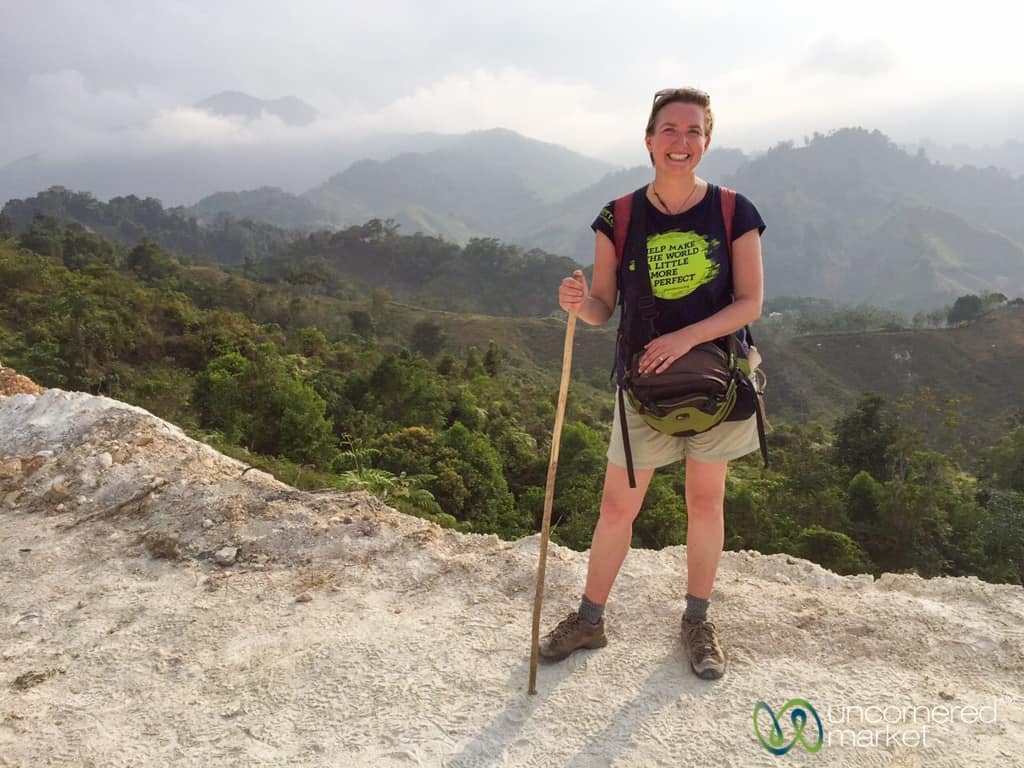 A walking stick, even a basic one like this, is essential for this trek.
A walking stick, even a basic one like this, is essential for this trek.Hiking Clothing for the Lost City Trek
You really don’t need much in the clothing department. Don’t worry about packing clean clothes for each day. You will be sweating buckets within minutes every morning of getting out on the trail.
Here’s what we suggest for hiking clothing and gear essentials:
1 set of hiking clothes: T-shirt (preferably quick dry), shorts, hiking socks. This means you will wear the same clothes every day. Don’t worry about it. Everyone does it. And you’ll be thankful not to carry the weight of extra clothes. Note: if mosquitoes love you, consider wearing hiking pants the whole time. Dan did this and it cut down on his mosquito bites considerably. If you are especially sun-sensitive, consider bringing a very light long-sleeved hiking shirt, but be aware that you may be warm.Hiking shoes: We wore low-rise hiking shoes (his and hers) and these worked great for us. Other people wore light trainers, however some mid-ankle support is useful because of the pitch of the terrain.1 set of evening clothes for post-shower and sleep: T-shirt, long pants (or pajama bottoms), socks. To ensure these remain dry, pack them in a plastic bag or other impermeable container inside your backpack.Extra t-shirt: Just in case.Underwear for every day of your trek: With an extra pair thrown in for good measure, if you like. Recommended his and hers quick dry underwear for men and women. Extra pair of socks: Just in case your first pair get soaked beyond comfort while rock jumping at the river crossings.Bathing suit: Keep near the top of your backpack to have handy for swimming holes.Long-sleeved shirt: For cool nights or sleeping (recommended his and hers).Fleece jacket: For cool nights or sleeping (can double as a pillow, too).Rain jacket (optional): We didn't use ours due to the heat and humidity. We appreciated the cool rain. Not to mention, a rain jacket in the tropics can feel like a personal sauna.Flip-flops or river shoes: To use in river crossings, showers, and evenings when you wish to get out of your hiking shoes. Women's Tevas | Men's TevasOther Essential Hiking Gear
Waterproof backpack cover: You never know when a rainstorm will hit, so it’s essential to keep a rain cover for your backpack close at hand. Your guide will likely also have a supply of plastic garbage bags in case you need extra rain protection.Quick-dry travel towel: To dry off after showers, and also after a swim. Hang it on the outside of your backpack in the morning so it dries quickly in the sun and air as you move.Silk sleep sack: To provide an extra layer between you and the hammock (or mattress) and blanket. Fleas and other bugs in the hammocks bit us and other travelers we spoke to.Headlamp: Most of the campsites do not have electricity, so be prepared. Carry your own headlamp to find your way to the toilet and to sort through your stuff at night in and around your hammock.Silicone earplugs: A precaution in the case your camp has a snorer. We know from our Lost City experience that this can demolish a good night’s sleep.Toiletries and Health Kit
You will have access to a shower every evening, and you will be so thankful for the cold water shower to wash away all the sweat and salt on your body from the day’s efforts.
Shampoo, soap, toothbrush and toothpaste: The basics.Sunscreen: The higher the SPF, the betterSunglasses: Of course.Bug repellent: You will apply this frequently, especially at the Lost City itself. The mosquitoes there are big, aggressive and plenty.Hand sanitizer: To be on the safe side.Pack of tissues or toilet paper: The campsites all have toilet paper, but it’s always a good idea to carry a pack of tissues in case of messes, spills or emergencies.Vitamin B Complex: Take one pill per day (called Complejo-B in Spanish, available at pharmacies in Colombia). Supposedly, mosquitoes don’t appreciate the smell and taste of your blood when B-1 Thiamine is present. It is debatable whether this really works to repel mosquitoes, but we appreciated using it and felt that it helped.Foot care and blisters: Duct tape is very effective for hot spots and blisters on your feet. Also consider picking up some Compeed, which is magic when you already have blisters.Medical Kit (for emergencies): Your guide will also have some basic first aid items with him, but it's always good to be prepared. Our basic medical kit includes: Band-Aids, anti-bacterial gel (for cuts), rehydration powders or electrolyte tablets, Azithromycin/Ciprofloxacin (or another medication against stomach bacteria), Tylenol/Panadol (anti-headache/aches), Immodium (or some sort of “stopper” if you get diarrhea), tea tree oil (great to apply to mosquito bites) Note: all these are easily and inexpensively purchased at local pharmacies, including in Santa Marta from where you depart for the trek.Electricity and Charging Batteries
While a couple of the campsites do have electricity, it’s unreliable. Prepare yourself for not having access to electricity during the trek. Some tips to handle this and further your battery power.
Put your smartphone on airplane mode. There is no connectivity along the trek anyhow, so don't waste your phone’s battery power trying to find a network.Consider buying a phone case that doubles as an extra battery. It provides another 1-1.5 charges.Take an extra camera battery or two.Don’t spent time reviewing your images, as this will eat up your battery power quickly. Unless you are reviewing images to determine whether you’ve captured a specific shot, there will be time enough for photo review when your trek is finished.G Adventures Lost City Trek Options
G Adventures Lost City Trek Tours
Here are some of the G Adventures Lost City Trek small group tour options. These G Adventures tours all include an indigenous guide and all the support you need for a successful hike to La Ciudad Perdida in northern Colombia.
Colombia - Lost City Trekking (7 days)
The Lost City Trek tour we took that included all the experiences in this article, including an indigenous guide and cultural experience. The tour is 7-days and begins and ends in Santa Marta with 5 days of hiking the Lost City Trek.



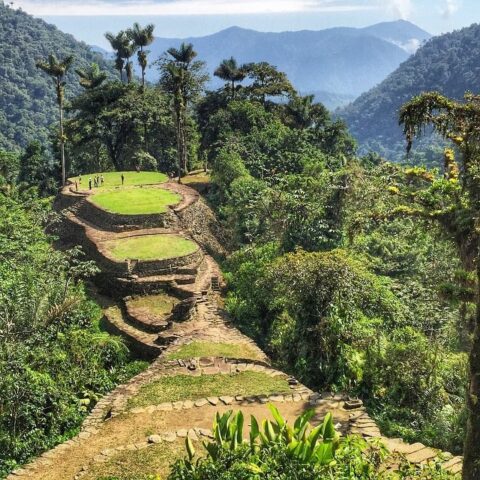



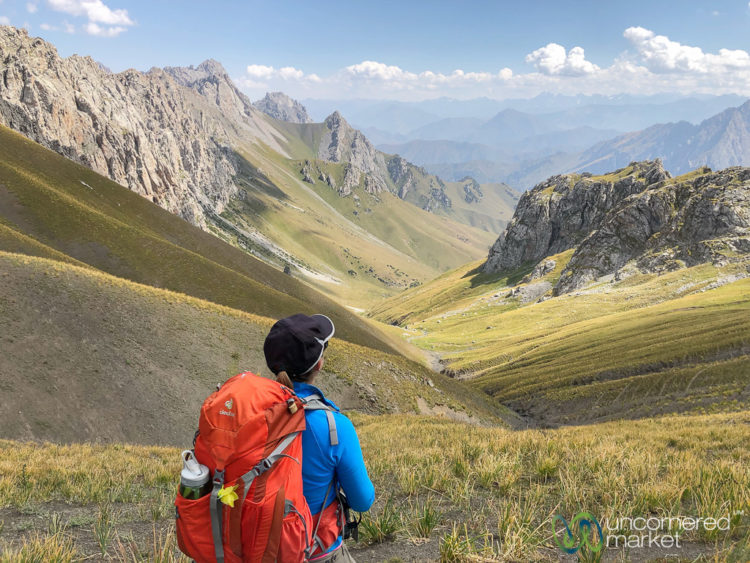
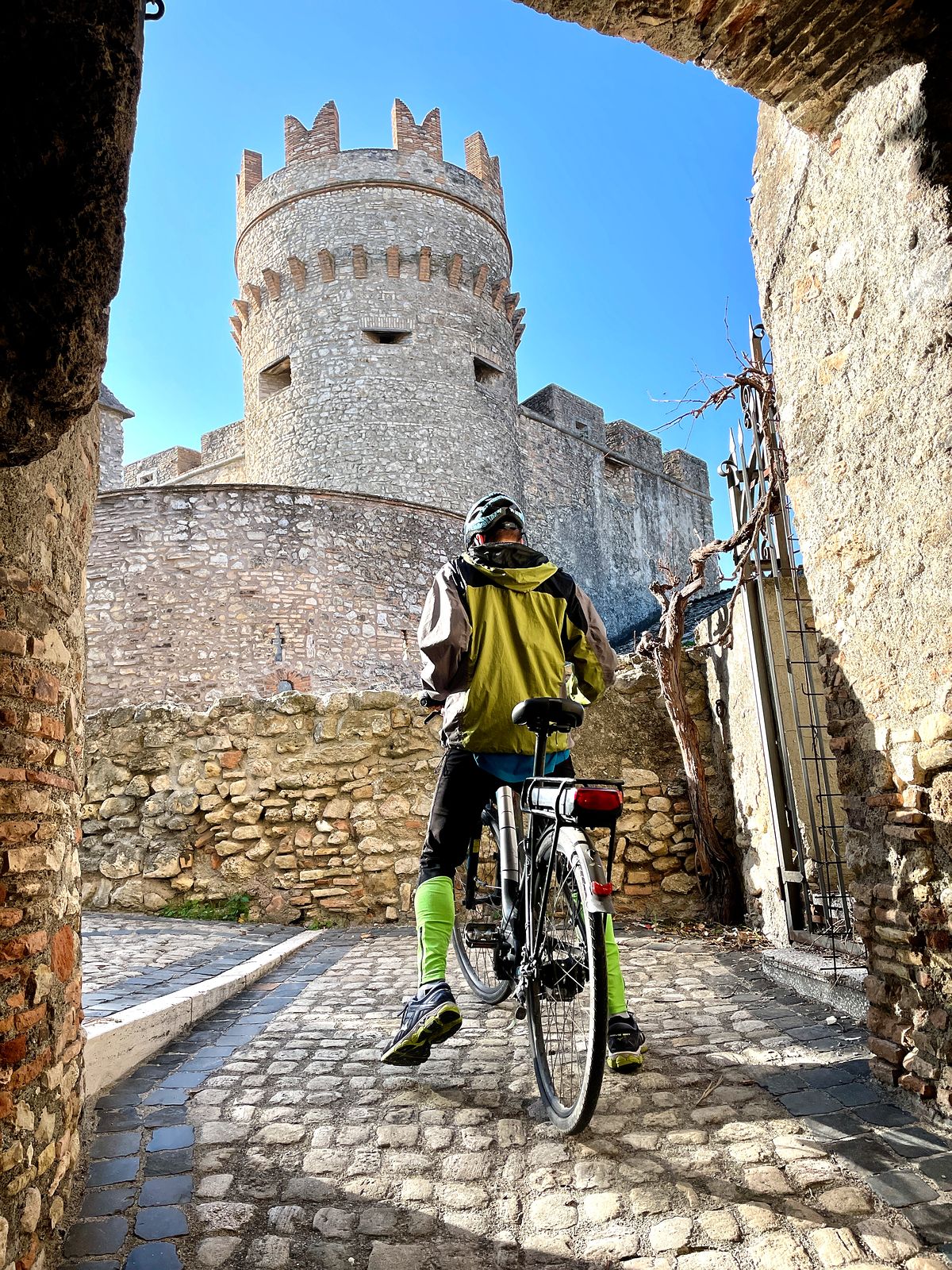
![Berlin Christmas Markets: The Ultimate Guide [Updated 2022]](https://uncorneredmarket.com/wp-content/uploads/2017/10/Berlin_Christmas_Markets_Gendarmenmarkt.jpg)
